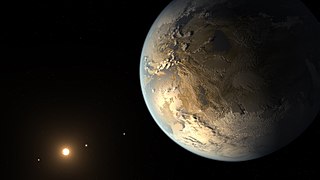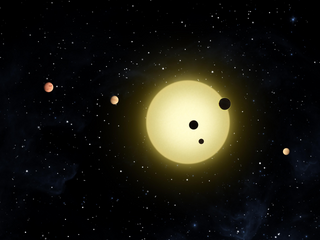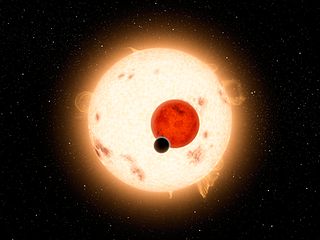
These are lists of exoplanets. As of 19 December 2023, there are 5,566 confirmed exoplanets in 4,140 planetary systems, with 942 systems having more than one planet. Most of these were discovered by the Kepler space telescope. There are an additional 1,984 potential exoplanets from Kepler's first mission yet to be confirmed, as well as 977 from its "Second Light" mission and 4,589 from the Transiting Exoplanet Survey Satellite (TESS) mission.
This page describes exoplanet orbital and physical parameters.

HAT-P-11b is an extrasolar planet orbiting the star HAT-P-11. It was discovered by the HATNet Project team in 2009 using the transit method, and submitted for publication on 2 January 2009.

Kepler-8b is the fifth of the first five exoplanets discovered by NASA's Kepler spacecraft, which aims to discover planets in a region of the sky between the constellations Lyra and Cygnus that transit their host stars. The planet is the hottest of the five. Kepler-8b was the only planet discovered in Kepler-8's orbit, and is larger than Jupiter. It orbits its host star every 3.5 days. The planet also demonstrates the Rossiter–McLaughlin effect, where the planet's orbit affects the redshifting of the spectrum of the host star. Kepler-8b was announced to the public on January 4, 2010 at a conference in Washington, D.C. after radial velocity measurements conducted at the W.M. Keck Observatory confirmed its detection by Kepler.

Kepler-6 is a G-type star situated in the constellation Cygnus. The star lies within the field of view of the Kepler Mission, which discovered it as part of a NASA-led mission to discover Earth-like planets. The star, which is slightly larger, more metal-rich, slightly cooler, and more massive than the Sun, is orbited by at least one extrasolar planet, a Jupiter-sized planet named Kepler-6b that orbits closely to its star.
Kepler-8 is a star located in the constellation Lyra in the field of view of the Kepler Mission, a NASA-led operation tasked with discovering terrestrial planets. The star, which is slightly hotter, larger, and more massive than the Sun, has one gas giant in its orbit, Kepler-8b. This gas giant is larger than Jupiter, but is less massive, and thus more diffuse. The planet's discovery was announced to the public on January 4, 2010 along with four other planets. As the fifth confirmed planetary system verified by Kepler, it helped demonstrate the capabilities of the Kepler spacecraft.

Kepler-9 is a sunlike star in the constellation Lyra. Its planetary system, discovered by the Kepler Mission in 2010 was the first detected with the transit method found to contain multiple planets.

Kepler-9b is one of the first planets discovered outside the solar system (exoplanets) by NASA's Kepler Mission. It revolves around the star Kepler-9 within the constellation Lyra. Kepler-9b is the largest of three planets detected in the Kepler system by transit method; its mass is roughly half that of the planet Saturn, and it is the largest planet in its system. Kepler-9b and Kepler-9c display a phenomenon called orbital resonance, in which gravitational pull from each planet alters and stabilizes the orbit of the other. The planet's discovery was announced on August 26, 2010.

An exoplanet is a planet located outside the Solar System. The first evidence of an exoplanet was noted as early as 1917, but was not recognized as such until 2016; no planet discovery has yet come from that evidence. What turned out to be the first detection of an exoplanet was published among a list of possible candidates in 1988, though not confirmed until 2003. The first confirmed detection came in 1992, with the discovery of terrestrial-mass planets orbiting the pulsar PSR B1257+12. The first confirmation of an exoplanet orbiting a main-sequence star was made in 1995, when a giant planet was found in a four-day orbit around the nearby star 51 Pegasi. Some exoplanets have been imaged directly by telescopes, but the vast majority have been detected through indirect methods, such as the transit method and the radial-velocity method. As of 1 December 2023, there are 5,550 confirmed exoplanets in 4,089 planetary systems, with 887 systems having more than one planet. This is a list of the most notable discoveries.

Kepler-10b is the first confirmed terrestrial planet to have been discovered outside the Solar System by the Kepler Space Telescope. Discovered after several months of data collection during the course of the NASA-directed Kepler Mission, which aims to discover Earth-like planets crossing in front of their host stars, the planet's discovery was announced on January 10, 2011. Kepler-10b has a mass of 3.72±0.42 Earth masses and a radius of 1.47 Earth radii. However, it lies extremely close to its star, Kepler-10, and as a result is too hot to support life as we know it. Its existence was confirmed using measurements from the W.M. Keck Observatory in Hawaii.

Kepler-10, formerly known as KOI-72, is a Sun-like star in the constellation of Draco that lies 607 light-years from Earth. Kepler-10 was targeted by NASA's Kepler spacecraft, as it was seen as the first star identified by the Kepler mission that could be a possible host to a small, transiting exoplanet. The star is slightly less massive, slightly larger, and slightly cooler than the Sun; at an estimated 11.9 billion years in age, Kepler-10 is almost 2.6 times the age of the Sun.

Kepler-11, also designated as 2MASS J19482762+4154328, is a Sun-like star slightly larger than the Sun in the constellation Cygnus, located some 2,150 light years from Earth. It is located within the field of vision of the Kepler spacecraft, the satellite that NASA's Kepler Mission uses to detect planets that may be transiting their stars. Announced on February 2, 2011, the star system is among the most compact and flattest systems yet discovered. It is the first discovered case of a star system with six transiting planets. All discovered planets are larger than Earth, with the larger ones being about Neptune's size.

Kepler-11b is an exoplanet discovered around the star Kepler-11 by the Kepler spacecraft, a NASA-led mission to discover Earth-like planets. Kepler-11b is less than about three times as massive and twice as large as Earth, but it has a lower density, and is thus most likely not of Earth-like composition. Kepler-11b is the hottest of the six planets in the Kepler-11 system, and orbits more closely to Kepler-11 than the other planets in the system. Kepler-11b, along with its five counterparts, form the first discovered planetary system with more than three transiting planets—the most densely packed known planetary system. The system is also the flattest known planetary system. The discovery of this planet and its five sister planets was announced on February 2, 2011, after follow-up investigations.

Kepler-11c is an exoplanet discovered in the orbit of the Sun-like star Kepler-11 by the Kepler spacecraft, a NASA telescope aiming to discover Earth-like planets. It is the second planet from its star, and is most likely a water planet with a thin hydrogen–helium atmosphere. Kepler-11c orbits Kepler-11 every 10 days, and has an estimated density twice that of pure water. It is estimated to have a mass thirteen times that of Earth and a radius three times that of Earth. Kepler-11c and its five sister planets form the first discovered system with more than three transiting planets. The Kepler-11 system also holds the record of being the most compact and the flattest system discovered. Kepler-11c and the other Kepler-11 planets were announced to the public on February 2, 2011, and was published in Nature a day later.

Kepler-11d is an exoplanet discovered in the orbit of the sun-like star Kepler-11. It is named for the telescope that discovered it, a NASA spacecraft named Kepler that is designed to detect Earth-like planets by measuring small dips in the brightness of their host stars as the planets cross in front. This process, known as the transit method, was used to note the presence of six planets in orbit around Kepler-11, of which Kepler-11d is the third from its star. Kepler-11d orbits Kepler-11 well within the orbit of Mercury approximately every 23 days. The planet is approximately six times more massive than the Earth, and has a radius that is three and a half times larger than that of Earth's. It is, however, far hotter than Earth is. Its low density, comparable to that of Saturn, suggests that Kepler-11d has a large hydrogen–helium atmosphere. Kepler-11d was announced with its five sister planets on February 2, 2011 after extensive follow-up studies.

Kepler-11e is an exoplanet discovered in the orbit of the sunlike star Kepler-11. It is the fourth of six planets around Kepler-11 discovered by NASA's Kepler spacecraft. Kepler-11e was found by using the transit method, in which the dimming effect that a planet causes as it crosses in front of its star is measured. Kepler-11e is most likely a gas giant like Neptune, having a density that is less than that of Saturn, the least dense planet in the Solar System. Its low density can probably be attributed to a large hydrogen and helium atmosphere. Kepler-11e has a mass eight times of Earth's mass and a radius 4.5 times that of Earth. The planet orbits its star every 31 days in an ellipse that would fit within the orbit of Mercury. Kepler-11e was announced on February 2, 2011 with its five sister planets after it was confirmed by several observatories.

Kepler-11f is an exoplanet discovered in the orbit of the sun-like star Kepler-11 by NASA's Kepler spacecraft, which searches for planets that transit their host stars. Kepler-11f is the fifth planet from its star, orbiting one quarter of the distance of the Earth from the Sun every 47 days. It is the furthest of the first five planets in the system. Kepler-11f is the least massive of Kepler-11's six planets, at nearly twice the mass of Earth; it is about 2.6 times the radius of Earth. Along with planets d and e and unlike the two inner planets in the system, Kepler-11f has a density lower than that of water and comparable to that of Saturn. This suggests that Kepler-11f has a significant hydrogen–helium atmosphere. The Kepler-11 planets constitute the first system discovered with more than three transiting planets. Kepler-11f was announced to the public on February 2, 2011, after follow-up investigations at several observatories. Analysis of the planets and study results were published the next day in the journal Nature.

Kepler-9d is a planet in orbit around the Sun-like star Kepler-9. Initially discovered by Kepler spacecraft, a terrestrial planet-searching satellite built and operated by NASA, Kepler-9d is most likely a Super-Earth, with an estimated radius approximately 60% larger than that of Earth's, although its exact mass cannot be determined. Kepler-9d orbits Kepler-9 every 1.56 days at a distance of .0273 AU from its star, an extremely close distance. Although Kepler-9d is the closest planet to its star in its system, it is named Kepler-9d instead of Kepler-9b because two gas giants, Kepler-9b and Kepler-9c, were confirmed first. The original studies into the system first suggested that Kepler-9d might be a planet, but a follow-up investigation made by the Kepler team later confirmed that it was; the confirmation of Kepler-9d as a planet was made public with the team's paper, which was published in the Astrophysical Journal on January 1, 2011. The team used telescopes at the W.M. Keck Observatory in Hawaii to follow up on the Kepler space telescope's initial discovery.

Kepler-16b is an exoplanet. It is a Saturn-mass planet consisting of half gas and half rock and ice, and it orbits a binary star, Kepler-16, with a period of 229 days. "[It] is the first confirmed, unambiguous example of a circumbinary planet – a planet orbiting not one, but two stars," said Josh Carter of the Center for Astrophysics | Harvard & Smithsonian, one of the discovery team.

Kepler-90, also designated 2MASS J18574403+4918185, is a G-type star located about 2,790 light-years (855 pc) from Earth in the constellation of Draco. It is notable for possessing a planetary system that has the same number of observed planets as the Solar System.

















